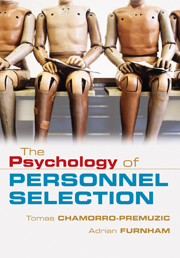Book contents
- Frontmatter
- Contents
- List of boxes
- List of figures
- List of tables
- Prologue and acknowledgements
- Part 1 Methods of personnel selection
- 1 Early, unscientific methods
- 2 The interview
- 3 Letters of recommendation
- 4 Biodata
- 5 Situational judgement tests and GPA
- Part 2 Constructs for personnel selection
- References
- Index
5 - Situational judgement tests and GPA
from Part 1 - Methods of personnel selection
Published online by Cambridge University Press: 05 June 2012
- Frontmatter
- Contents
- List of boxes
- List of figures
- List of tables
- Prologue and acknowledgements
- Part 1 Methods of personnel selection
- 1 Early, unscientific methods
- 2 The interview
- 3 Letters of recommendation
- 4 Biodata
- 5 Situational judgement tests and GPA
- Part 2 Constructs for personnel selection
- References
- Index
Summary
Situational judgement tests
Situational judgement tests (SJTs) – of one form or another – have been used in personnel selection and examined in applied psychological research for many decades. However, the term ‘SJT’ is relatively more recent and the boundaries of what should constitute a SJT have only been defined relatively recently. In a seminal review of the topic a few years back SJTs were defined as ‘any paper-and-pencil test designed to measure judgment in work settings’ (McDaniel, Morgeson, Finnegan, Campion & Braverman, 2001, p. 730). Although this definition is too broad in a sense (cognitive ability tests, for instance, are not considered SJTs even though they may be designed to measure judgement at work) and too specific in others (SJTs are not only available in paper-and-pencil forms and can also be used to assess things other than judgement at work), it represents a useful operationalisation of SJTs. Indeed, McDaniel et al. organised many decades of research on the SJT on the basis of this operationalisation, as well as providing a widely cited meta-analytic estimate of the correlation between SJT and work criteria on the one hand, and cognitive ability on the other. Needless to say, the SJT is a measurement method rather than a construct (hence it is included in the first half of the current book rather than the second one, which deals with constructs; see, for instance, Chapters 6, 7 and 8).
- Type
- Chapter
- Information
- The Psychology of Personnel Selection , pp. 75 - 92Publisher: Cambridge University PressPrint publication year: 2010



